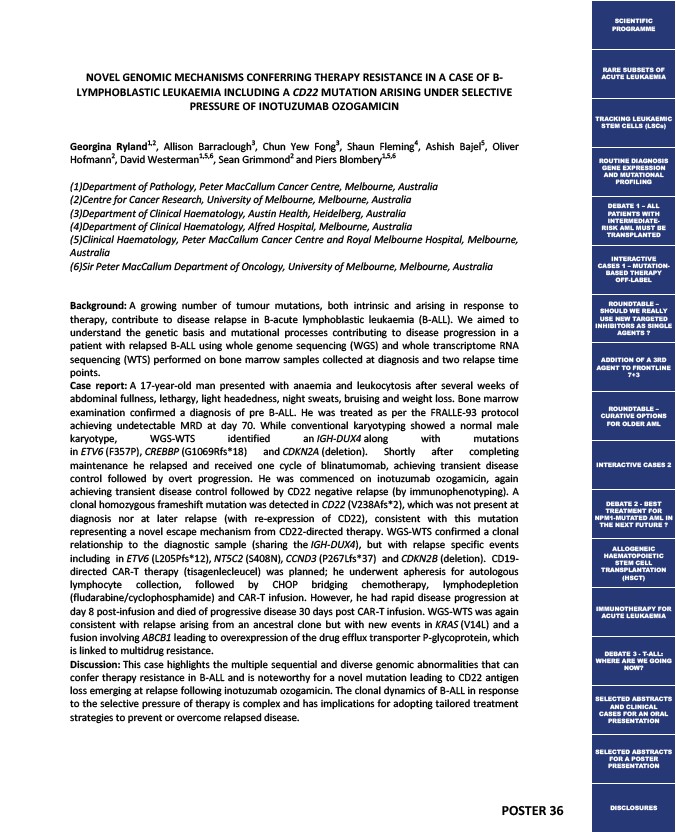
NOVEL GENOMIC MECHANISMS CONFERRING THERAPY RESISTANCE IN A CASE OF B-LYMPHOBLASTIC
LEUKAEMIA INCLUDING A CD22 MUTATION ARISING UNDER SELECTIVE
POSTER 36
PRESSURE OF INOTUZUMAB OZOGAMICIN
Georgina Ryland1,2, Allison Barraclough3, Chun Yew Fong3, Shaun Fleming4, Ashish Bajel5, Oliver
Hofmann2, David Westerman1,5,6, Sean Grimmond2 and Piers Blombery1,5,6
(1)Department of Pathology, Peter MacCallum Cancer Centre, Melbourne, Australia
(2)Centre for Cancer Research, University of Melbourne, Melbourne, Australia
(3)Department of Clinical Haematology, Austin Health, Heidelberg, Australia
(4)Department of Clinical Haematology, Alfred Hospital, Melbourne, Australia
(5)Clinical Haematology, Peter MacCallum Cancer Centre and Royal Melbourne Hospital, Melbourne,
Australia
(6)Sir Peter MacCallum Department of Oncology, University of Melbourne, Melbourne, Australia
Background: A growing number of tumour mutations, both intrinsic and arising in response to
therapy, contribute to disease relapse in B-acute lymphoblastic leukaemia (B-ALL). We aimed to
understand the genetic basis and mutational processes contributing to disease progression in a
patient with relapsed B-ALL using whole genome sequencing (WGS) and whole transcriptome RNA
sequencing (WTS) performed on bone marrow samples collected at diagnosis and two relapse time
points.
Case report: A 17-year-old man presented with anaemia and leukocytosis after several weeks of
abdominal fullness, lethargy, light headedness, night sweats, bruising and weight loss. Bone marrow
examination confirmed a diagnosis of pre B-ALL. He was treated as per the FRALLE-93 protocol
achieving undetectable MRD at day 70. While conventional karyotyping showed a normal male
karyotype, WGS-WTS identified an IGH-DUX4 along with mutations
in ETV6 (F357P), CREBBP (G1069Rfs*18) and CDKN2A (deletion). Shortly after completing
maintenance he relapsed and received one cycle of blinatumomab, achieving transient disease
control followed by overt progression. He was commenced on inotuzumab ozogamicin, again
achieving transient disease control followed by CD22 negative relapse (by immunophenotyping). A
clonal homozygous frameshift mutation was detected in CD22 (V238Afs*2), which was not present at
diagnosis nor at later relapse (with re-expression of CD22), consistent with this mutation
representing a novel escape mechanism from CD22-directed therapy. WGS-WTS confirmed a clonal
relationship to the diagnostic sample (sharing the IGH-DUX4), but with relapse specific events
including in ETV6 (L205Pfs*12), NT5C2 (S408N), CCND3 (P267Lfs*37) and CDKN2B (deletion). CD19-
directed CAR-T therapy (tisagenlecleucel) was planned; he underwent apheresis for autologous
lymphocyte collection, followed by CHOP bridging chemotherapy, lymphodepletion
(fludarabine/cyclophosphamide) and CAR-T infusion. However, he had rapid disease progression at
day 8 post-infusion and died of progressive disease 30 days post CAR-T infusion. WGS-WTS was again
consistent with relapse arising from an ancestral clone but with new events in KRAS (V14L) and a
fusion involving ABCB1 leading to overexpression of the drug efflux transporter P-glycoprotein, which
is linked to multidrug resistance.
Discussion: This case highlights the multiple sequential and diverse genomic abnormalities that can
confer therapy resistance in B-ALL and is noteworthy for a novel mutation leading to CD22 antigen
loss emerging at relapse following inotuzumab ozogamicin. The clonal dynamics of B-ALL in response
to the selective pressure of therapy is complex and has implications for adopting tailored treatment
strategies to prevent or overcome relapsed disease.
SCIENTIFIC
PROGRAMME
RARE SUBSETS OF
ACUTE LEUKAEMIA
TRACKING LEUKAEMIC
STEM CELLS (LSCs)
ROUTINE DIAGNOSIS
GENE EXPRESSION
AND MUTATIONAL
PROFILING
DEBATE 1 – ALL
PATIENTS WITH
INTERMEDIATE-RISK
AML MUST BE
TRANSPLANTED
INTERACTIVE
CASES 1 – MUTATION-BASED
THERAPY
OFF-LABEL
ROUNDTABLE –
SHOULD WE REALLY
USE NEW TARGETED
INHIBITORS AS SINGLE
AGENTS ?
ADDITION OF A 3RD
AGENT TO FRONTLINE
7+3
ROUNDTABLE –
CURATIVE OPTIONS
FOR OLDER AML
INTERACTIVE CASES 2
DEBATE 2 - BEST
TREATMENT FOR
NPM1-MUTATED AML IN
THE NEXT FUTURE ?
ALLOGENEIC
HAEMATOPOIETIC
STEM CELL
TRANSPLANTATION
(HSCT)
IMMUNOTHERAPY FOR
ACUTE LEUKAEMIA
DEBATE 3 - T-ALL:
WHERE ARE WE GOING
NOW?
SELECTED ABSTRACTS
AND CLINICAL
CASES FOR AN ORAL
PRESENTATION
SELECTED ABSTRACTS
FOR A POSTER
PRESENTATION
DISCLOSURES